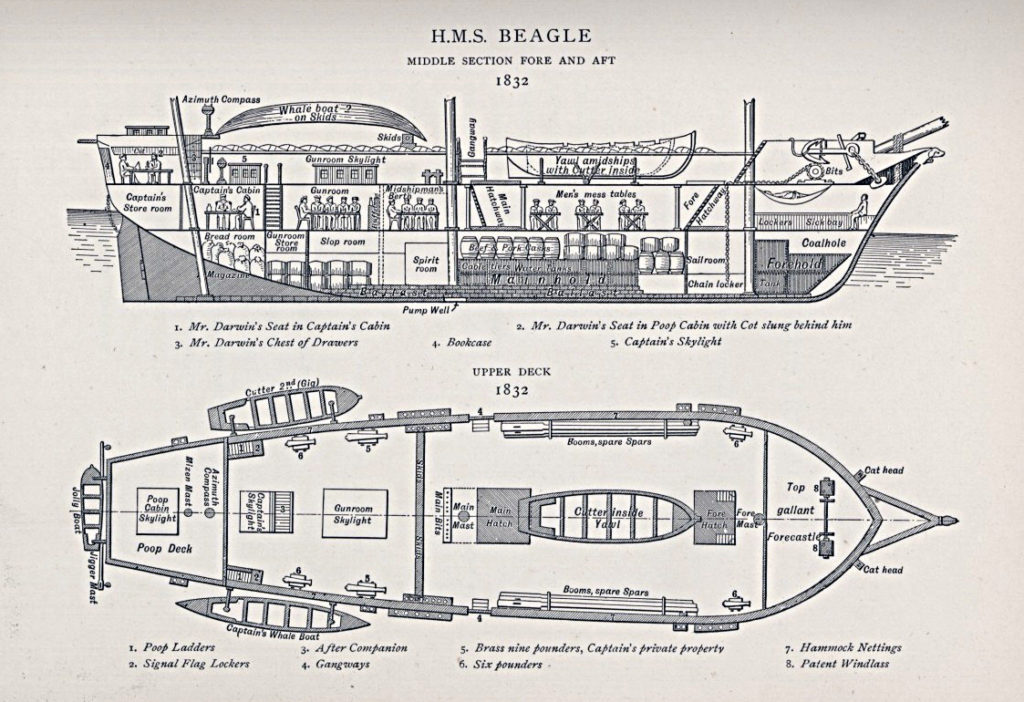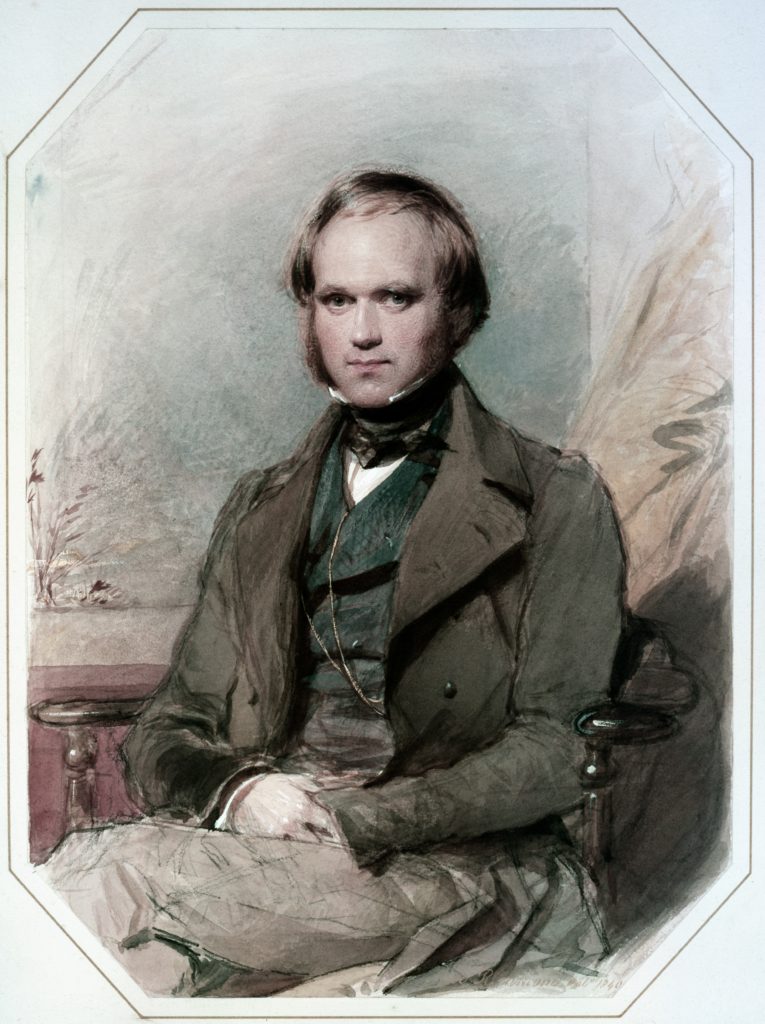It’s a few days after Christmas, and some of the fortunate among us are escaping the winter for cruises to the Caribbean. On this date—December 27—a different sort of cruise began in 1831. That cruise lasted 1742 days, and the results changed the entire way civilization viewed the world.

The vessel conducting the cruise was His Majesty’s Ship Beagle. HMS Beagle was one of more than 100 built in the design of a “10-gun brig-sloop.” It was relatively small (90 feet 4 inches long), with two masts. Launched in 1820, Beagle’s task was to scout for larger ships and convoys and to transport letters and other light materials from place to place (learn more about the ship here) . A few years later, Beagle was refitted with a small third mast (making it a “bark”), a small cabin and some additional features for more extensive journeys.
And so, in 1826, HMS Beagle embarked on its first major journey. The task was to survey the coasts of South America, taking hydrologic and cartographic measurements. Two years into the voyage, the original captain became depressed and shot himself. The second-in-command, Lieutenant Robert Fitzroy, took over as captain. The voyage ended in 1930, after four years exploring the South American coast.

The first voyage just whetted England’s appetite for information about South America and the lands and waters of the Pacific Ocean. So, Beagle was given another make-over—the deck was raised one foot, the hull was made two inches thicker, 22 chronometers and much scientific equipment were put on board—in readiness for its second major voyage. Fitzroy was re-appointed the captain with a similar but larger challenge—resurvey all the coasts of South America, then traverse the entire southern ocean to survey the complete latitude of the earth.
There was also a secondary task of “collecting, observing, and noting, anything worthy to be noted in Natural History.” At the time, natural history meant not only living plants and animals, but also geologic materials and fossils. Fitzroy realized he needed help—and that he needed a gentleman peer to accompany him as an equal, to provide companionship (he didn’t want to end up like Beagle’s previous captain). After some false starts, he eventually settled on a 22-year-old graduate of Cambridge who planned to be a clergyman but was also an amateur naturalist eager for an adventure. That man was Charles Darwin.

After several months of delays, HMS Beagle left Portsmouth, England, on December 27, 1831, commencing a five-year voyage that covered nearly 40,000 miles. The early voyage wasn’t pleasant for Darwin. He wrote, “The misery I endured from sea-sickness is far beyond what I ever guessed at.” The ship was so crowded that he slept in a hammock suspended over the small table in the main cabin. But things got much better after the ship reached South American. In February, 1832, he caught his first glimpse of the rainforest in Brazil, noting, “Here I first saw a tropical forest in all its sublime grandeur…I never experienced such intense delight.”
Darwin’s job was to explore the lands the ship encountered. He understood that this was an extraordinary opportunity, noting that “[N]othing can be more improving to a young naturalist, than a journey in a distant country.” So, he went off on expeditions for much of the voyage, tramping some 2,000 miles in all. He spent only 18 months aboard Beagle during its five years at sea. He made good use of his time onshore, collecting 5,000 specimens of plants, animals, minerals and fossils and filling dozens of notebooks with his observations. Throughout the journey, he sent his specimens back to England where they could be examined by experts. Most of the specimens were new to science, and, consequently, Darwin’s reputation as a naturalist grew while he was on the voyage, and he returned home in 1836 as a well-established scientist.

Darwin kept working on his specimens and his theories, eventually bringing us natural selection, evolution and, really, ecology (learn more about Darwin’s work here). The Beagle, however, wasn’t so fortunate. It took one more significant voyage, to survey the entire coast of Australia. By 1845, however, the ship had outlived its usefulness. The masts were removed and it was moored in the estuary at Essex, England, as a lookout for smugglers. The ship’s name changed to Watch Vessel 7. And in 1870, it was sold for scrap.
References:
American Museum of Natural History. A Trip Around the World (Part of the Darwin exhibition). Available at: https://www.amnh.org/exhibitions/darwin/a-trip-around-the-world. Accessed January 15, 2020.
The HMS Beagle Project. HMS Beagle’s Second Voyage. Available at: Accessed January 15, 2020.https://hmsbeagleproject.org/the-timeline/hms-beagles-second-voyage/.
Thomson, Keith S. Beagle. Encyclopedia Britannica. Available at: https://www.britannica.com/topic/Beagle-ship. Accessed January 15, 2020.
Tietz, Tabea. 2015. The second Voyage of the HMS Beagle. SciHi Blog, 27 December 2015. Available at: http://scihi.org/second-voyage-beagle/ Accessed January 15, 2020.
Tripline. The Second Voyage of the HMS Beagle. Available at: https://www.tripline.net/trip/The_Second_Voyage_of_the_HMS_Beagle-5024671157051002B40CB47E6691EAB3. Accessed January 15, 2020.
